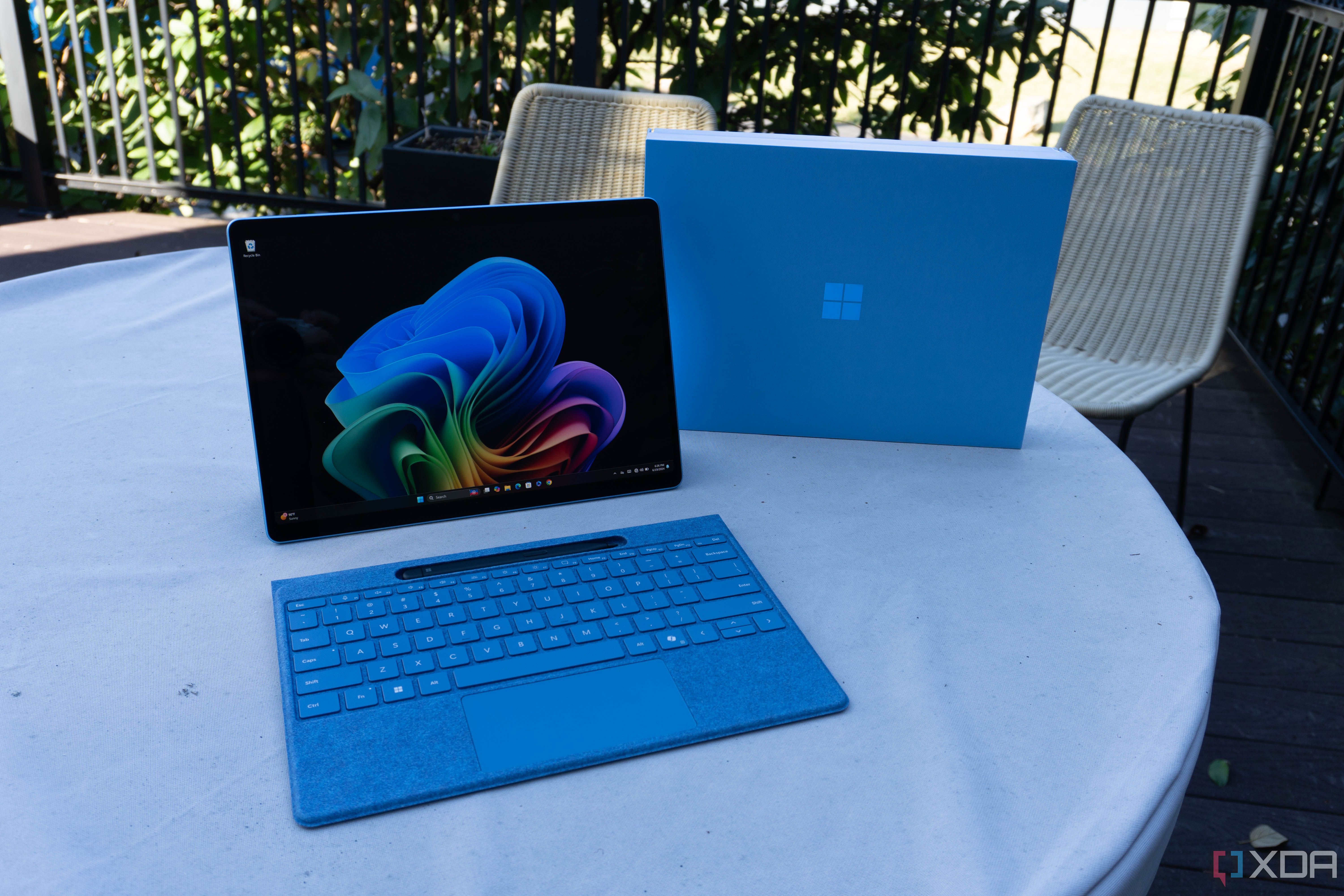Tech
Surface Pro 11 and Surface Laptop 7 performance testing and first impressions: Snapdragon X Elite is finally here

Ever since 2016 when Windows on Arm was introduced, I’ve been waiting for it to get good. Now, the time is finally here, as Snapdragon X Elite laptops have begun to ship. Currently, I’ve got my hands on the Surface Pro 11, Surface Laptop 7, and HP EliteBook Ultra, and I’ve been spending the last two days running tests on them.
I’m not going to talk a whole lot about the HP EliteBook Ultra today, because the benchmark scores are really wonky, and I suspect it’s going to need another firmware update. To put it simply, scores are reduced drastically when running on battery power, something that is not the case with the two Surface devices.
Benchmarks
A combination of native and emulated tests
I ran a pretty wide range of tests on these devices, including newer native tests like Geekbench 6.3 and Cinebench 2024, and older x64 tests like Cinebench R23. I’m also comparing the results to the Lenovo Yoga 9i, which uses an Intel Core Ultra 7 155H.
|
Surface Laptop 7 Snapdragon X1E-80-100 |
Surface Pro 11 Snapdragon X1E-80-100 |
Lenovo Yoga 9i Core Ultra 7 155H |
|
|---|---|---|---|
|
Geekbench 6.3 (single / multi) |
2,803 / 14,497 |
2,803 / 14,471 |
2,558 / 13,840 |
|
Cinebench 2024 (single / multi) |
124 / 972 |
121 / 836 |
104 / 544 |
|
Cinebench R23 (x86) (single / multi) |
1,304 / 10,021 |
1,306 / 8,676 |
1,782 / 11,240 |
|
3DMark: Time Spy (x86) |
1,892 |
1,909 |
3,368 |
|
3DMark: Wild Life (regular / Extreme) |
16,878 / 6,540 |
16,620 / 6,324 |
14,901 / 4,143 |
|
3DMark: Night Raid |
25,257 |
25,024 |
20,721 |
|
CrossMark (Overall) |
1,558 |
1,554 |
1,726 |
The Snapdragon X Elite definitely outperforms Intel’s Core Ultra 7, at least where native benchmarks are concerned. This is the middle of the pack X Elite, whereas the HP EliteBook Ultra has the Snapdragon X1E-78-100, and the scores seem to be more in line with what Intel is offering. Samsung is the only one using the top-end chip, in the Galaxy Book Edge, and there’s an additional SKU that’s dedicated to the dev kit.
There are so many variables though. While there are three (ish) tiers of the Snapdragon X Elite, OEMs can choose the TDP, so for example, Asus is claiming the best performance of the pack because it’s pumping 45W into its SoC, despite not using the top-end SKU.
I ran the tests when disconnected from power as well, and the results were nearly identical.
|
Surface Laptop 7 Snapdragon X1E-80-100 |
Surface Pro 11 Snapdragon X1E-80-100 |
Lenovo Yoga 9i Core Ultra 7 155H |
|
|---|---|---|---|
|
Geekbench 6.3 (single / multi) |
2,722 / 14,460 |
2,796 / 14,564 |
2,389 / 12,635 |
|
Cinebench 2024 (single / multi) |
121 / 960 |
121 / 840 |
105 / 543 |
|
Cinebench R23 (x86) (single / multi) |
1,313 / 10,135 |
1,303 / 9,173 |
1,786 / 10,476 |
|
3DMark: Time Spy (x86) |
1,904 |
1,906 |
3,338 |
|
3DMark: Wild Life (regular / Extreme) |
16,850 / 6,515 |
16,632 / 6,312 |
15,773 / 4,541 |
|
3DMark: Night Raid |
25,310 |
24,966 |
19,577 |
|
CrossMark (Overall) |
1,581 |
1,068 |
1,669 |
I was surprised at how well the Yoga 9i performed on battery, since that’s always been a shortcoming of x86. I’ve always felt like x86 laptops would have to basically trick you into getting better battery life, shutting off certain features and reducing performance.
It’s also very much up to the OEM, and that’s still the case with Snapdragon X Elite. Regarding the EliteBook Ultra, where the Geekbench multi-core score dropped from 13,266 to 5,760, I’ve reached out to HP to see if this is expected behavior, because OEMs do this type of thing so they can claim the best battery life. Still, I suspect it needs a firmware update.
Having a minimal performance impact when disconnected from power has been one of the strengths for Arm, as Apple has clearly demonstrated in its MacBooks. If there’s something you can do with a MacBook Pro when it’s plugged in, you can do it on battery power, something that is definitely not the case on Windows. The Yoga 9i might do well, but when you start adding in powerful discrete graphics, that idea goes out the window.
Some things don’t work
There are still some rare compatibility issues
Ahead of the Snapdragon X Elite launch, lots and lots of apps have gone native to Arm. Google Chrome is finally here, as is Slack and pretty much every web browser out there. On top of that, Microsoft’s new Prism emulator is surprisingly legit, something that really wasn’t my experience when I tested it on X Elite hardware back in March.
The only app I use that still runs in emulation is Adobe Lightroom Classic, and that was really smooth. The one part that’s still painfully slow is the AI denoise feature.
However, there are still some things that just don’t work. Firstly, a bunch of games won’t download. Yes, I wanted to test out gaming on an Arm PC, and why shouldn’t I? Qualcomm has been talking up gaming performance for months, promising that games will “just work” and putting on numerous in-person gaming demos.
The one I really wanted to play is Forza Horizon 5, a game from a franchise that has a long history of being able to run decently on integrated graphics. And that’s the story here. Aside from performance and battery life, these Snapdragon PCs need to do everything you’d expect to be able to do on a laptop. They’re not gaming PCs, but they need to run the software you’d be able to on an Intel laptop.
The Windows Subsystem for Android doesn’t seem to work at all, which is surprising because it works just fine on other Arm PCs I’ve used. Indeed, I’ve been using the Lenovo ThinkPad X13s and Surface Pro 9 5G quite a bit leading up to this launch (they’re surprisingly good now that so many apps are native).
There likely won’t be a fix for my WSA issue. Android apps on Windows are going to be killed off next March, so I don’t think Microsoft is going to put any effort into fixing them. Still, it’s a little strange that WSA comes pre-installed on the new Surface hardware when you can’t even search for the Amazon Appstore in the Microsoft Store anymore.
Either way, I love WSA and I want it to work while it still exists.
The Surface Pro 11 and Surface Laptop 7 are amazing
They’re some of the best laptops I’ve ever used
Aside from benchmark scores and the minor issues I outlined above, these products are fantastic. Performance is great, and the hardware changes that Microsoft made with this generation are smart.
As I suspected from the launch event, the Flex Keyboard for the Surface Pro 11 is a game changer. I may never use the product with the keyboard attached again. For such a small product, it makes a huge difference to be able to push the screen back to a more comfortable distance from my eyes.
The haptic touchpad on both the Flex Keyboard and the Surface Laptop 7 are great too. At the launch event, I jokingly asked a Surface rep, “Why do you hate quiet things?” Touchpads and keyboards on Surface products have always been so loud, and it’s always felt like the team has had a fetish for things that make clicking noises ever since the Surface RT.
For the Laptop 7, the bezels are smaller, the webcam is better, and it finally feels modern. This is the first chassis update since the product was first introduced in 2017.
I’ll have more on how much I love these products when I have a full review. Remember, I’ve only been using them a couple of days so far. It’s way too soon to draw full conclusions.
You can skip Copilot+
Without Recall, it seems useless
Microsoft unveiled Copilot+ on May 20, promising to change the way you use your PC. There were some big promises made, and those promises still make sense. We’re entering a new era of computing, where your device will be smarter about what it does.
The hero feature was Recall, something that takes a screenshot of your PC every few seconds and will make those images searchable based on what’s in them. For example, you’re looking for a new pair of sneakers and you’ve looked at dozens of options. You want to go back one you liked, but you’ve forgotten what it’s called. You’d be able to search Recall with a description of the shoe.

Related
Copilot+ is now here: Let’s clear up everything about that controversial Recall feature
You can now go out and grab a device that can run Copilot+, so let’s explore how Microsoft has handled the Recall issue before you buy one.
Recall was a PR nightmare for a variety of reasons, which I’ve talked about at length and are outside the scope of this article. The point is that Copilot+ PCs don’t have it, so the experience is limited to things like Cocreator, Live Captions, and Windows Studio Effects.
Let’s start with Cocreator. It’s really cool, and it makes for a great demo. But in practice, it feels like a party trick. The feature lets you make a prompt for an image, and combined with a rough drawing, Cocreator generates an image. It’s fast and constantly reworks itself based on changes to the drawing and the prompt.
It’s just not useful. I don’t think that people that don’t draw wish they could.
Windows Studio Effects are fine. The new animations like watercolor or illustrated are things I’d never use. Background blur and noise suppression are already supported by whichever meeting software you’re using anyway.
Finally, Live Captions are fine. I used it a bit in meetings, and it’s useful at times. It’s not great at translation, based on my early impressions.
The point is, don’t buy these new PCs for Copilot+. Buy them because they’re great PCs, and maybe for Copilot+ once Recall is out and tested. But for now, nothing about Microsoft’s AI PC initiative is a game-changer.










